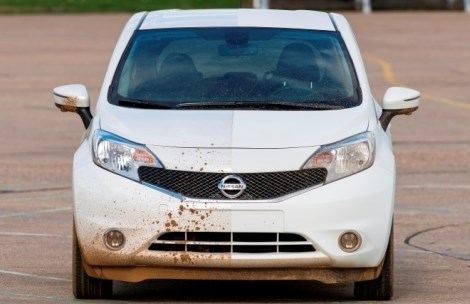New Nissan Paint Is "Self-Cleaning"
Super-hydrophobic and oleophobic paint which repels water and oils has been applied to the all-new European market Nissan Note to create the world's first self-cleaning car.

Nissan in Europe has begun tests on innovative paint technology that repels mud, rain and everyday dirt, meaning drivers may never have to clean their car again.
The specially engineered super-hydrophobic and oleophobic paint, which repels water and oils, has been applied to the all-new European market Nissan Note to create the world's first self-cleaning car. To assess the real-world effectiveness of the super-hydrophobic as a potential aftermarket application, engineers at Nissan Technical Centre Europe will be testing the self-cleaning Note over the coming months in a variety of conditions.
Nissan is the first carmaker to apply the technology, called Ultra-Ever Dry, on automotive bodywork. By creating a protective layer of air between the paint and environment, it effectively stops standing water and road spray from creating dirty marks on the car's surface.
So far, the coating, which is being marketed and sold by UltraTech International Inc, has responded well to common use cases including rain, spray, frost, sleet and standing water. Whilst there are currently no plans for the technology to be applied to the model as standard, Nissan will continue to consider the coating technology as a future aftermarket option.
“The Nissan Note has been carefully engineered to take the stress out of customer driving, and Nissan's engineers are constantly thinking of new ways to make families' lives easier,” said Geraldine Ingham, Chief Marketing Manager for Nissan Note. “We are committed to addressing everyday problems our customers face and will always consider testing exciting, cutting edge technology like this incredible coating application.”
-
Related Content
-
Pulling Out All the Stops
Evolving coatings and finishes for automotive brake components.
-
Henry Ford Is Still Right When It Comes to Color
Who would have imagined that more than 100 years after his famous statement about any color as long as it’s black would still have relevance of a sort?
-
Robots, AI and Superb BMW Surfaces
There isn’t an automotive paint shop in the world that doesn’t have post-paint inspection and defect processing. But BMW is doing this with levels of technology at a plant in Germany that exceed all other paint shops in the world.














.jpg;maxWidth=300;quality=90)
